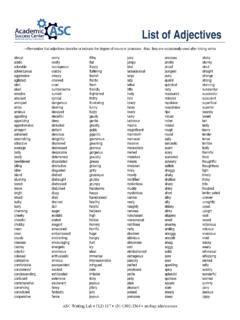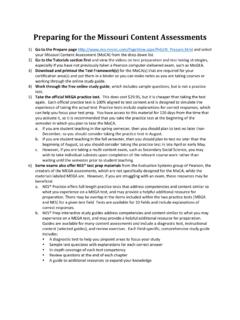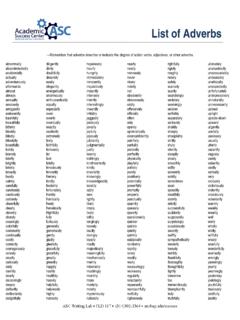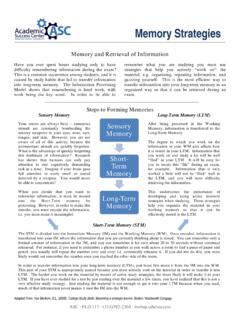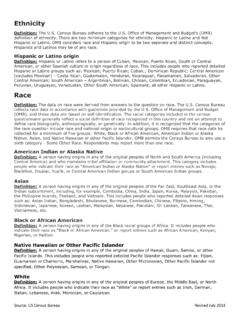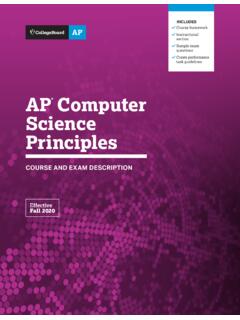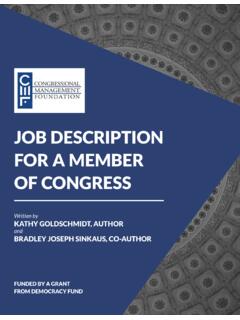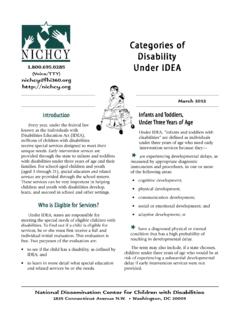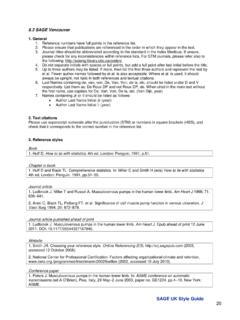Transcription of The Big Idea - Missouri Baptist University
1 the big idea (description) Provides a conceptual lens for prioritizing content. A Big Idea refers to core concepts, principles, theories, and processes that should serve as the focal point of curricula, instruction, and assessment. Big ideas reflect expert understanding and anchor the discourse, inquiries, discoveries, and arguments in a field of study. They provide a basis for setting curriculum priorities to focus on the most meaningful content. Big ideas function as the conceptual Velcro for a topic of study. They connect discrete knowledge and skills to a larger intellectual frame and provide a bridge for linking specific facts and skills. A focus on these larger ideas helps students to see the purpose and relevance of content. Discrete facts do not transfer. Big ideas are powerful because they embody transferable ideas , applicable to other topics, inquiries, contexts, issues and problems. Because we can never cover all the knowledge on a given topic, a focus on the Big ideas helps to manage information overload.
2 Big ideas provide the conceptual thought lines that anchor a coherent curriculum. A Big Idea is inherently abstract. Its meaning is not always obvious to students, and simply covering it will not ensure student understanding. Coverage is unlikely to cause genuine insight; understanding must be earned. Thus, the idea must be uncovered its meaning discovered, constructed or inferred by the learners, with the aid of the teacher and well-designed learning experiences. (McTighe & Wiggins, 2004, p. 69) Essential Questions (description) Have no simple right answer; they are meant to be argued. Essential Questions are designed to provoke and sustain student inquiry, while focusing learning and final performances. Essential questions yield inquiry and are argumentative. They serve as doorways into focused yet lively inquiry and research. They should uncover rather than cover the subject s controversies, puzzles, and perspectives.
3 They are intended to result in conclusions drawn by the learner, not recited facts. For example, Does art reflect culture or help shape it? Essential questions work best when they are designed and edited to be through provoking to students, engaging them in sustained, focused inquiries that culminate in important performance. Such questions often involve the counterintuitive, the visceral, the whimsical, the controversial, and the provocative. Essential questions reflect the most historically important issues, problems, and debates in a field of study. The same important questions are asked and asked again throughout one s learning and in the history of the field. Essential questions challenge our unexamined assumptions, the inevitable simplification of our earlier learning, and the arguments we may unthinkingly take for granted. They force us to ask deep questions about the nature, origin, and the extent of our understanding.
4 For example, In light of fractions, place value, irrationals, and negative square roots what is a number? Is it democratic to have an electoral college? (McTighe & Wiggins, 2004, p. 91) Essential Question Samples Arithmetic (numeration) What is a number? Why do we have numbers? What if we didn t have numbers? Can everything be quantified? Arts (visual and performing) Where do artists get their ideas : How does art reflect, a well as shape, culture? Culinary Arts When is it ok to deviate from the recipe? What makes a safe kitchen? Dance How and what can we communicate through the language of dance? In what ways can motion evoke emotion? Economics What determines value? Can macroeconomics inform microeconomics (and vice versa)? Foreign Language What distinguishes a fluent foreigner from a native speaker? What can we learn about our own language and culture from studying another? Geography What makes places unique and different? How does where we live influence how we live?
5 Government Who should decide? How should we balance the rights of individuals with the common good? Health What is healthy living? How can a diet be healthy for one person and not another? History Whose story is it? Is history told by the winners? What can we learn from the past? Literature What makes a great book? Can fiction reveal truth? Should a story teach you something? Mathematics When is the correct answer not the best solution? What are the limits of mathematical representation and modeling? Music How are sounds and silence organized in various musical forms? What roles does music play in the world? Physical Education and Athletics Who is a winner? Is pain necessary for progress in athletics? (No pain, no gain mentality) Reading and Language Arts What makes a great story? How do you read between the lines? Why do we punctuate? What if we didn t have punctuation marks? Science To what extent are science and common sense related? How are form and function related in biology?
6 Technology In what ways can technology enhance expression and communication? In what ways might technology hinder it? What are the pros and cons of technological progress? Writing Why write? How do effective writers hook and hold their readers? What is a complete thought? An Enduring Understanding (description) Involves the Big ideas that give meaning and importance to facts. An enduring understanding can transfer to other topics, fields, and adult life. It is usually not obvious, often counterintuitive, and easily misunderstood. Frame the desired understanding as a full-sentence generalization in response to the phrase. Students will understand Avoid the phrase, Students will understand how Enduring understandings are made up of the concepts, principles, and theories that weave many facts into revealing and useful patterns. They involve the (few) organizing priority ideas that enable us to make sense of past lessons, conduct current inquiry, and create new knowledge.
7 Such understandings endure in that they enable us to make vital and informative connections in our learning as students and as adults. For example, the idea that might does not make right applies to both playground disputes and international diplomacy. An understanding is an inference, not a fact. It is an insight derived from inquiry. Key understandings in intellectual fields often violate common sense and conventional wisdom. They are thus often prone to misunderstanding by students. These understandings therefore cannot be covered; they must be uncovered. Through skill-based teaching in mathematics, foreign language, and physical education does not seem to deal with understandings in most units, all skills derive their value from the strategic principles that help us know when and how to use the skill. The understandings also justify the use of a skill ( the students who can explain why you should use a bent-arm pull in swimming freestyle) and enable the student to extend the use of the skill to new situations.
8 An understanding is a generalization derived from inquiry. It is the specific insight that should be inferred from study of the topic. (McTighe & Wiggins, 2004, p. 115) Enduring Understanding Samples Arithmetic (numeration) Numbers are concepts that enable people to represent quantities, sequences, and rates. Different number systems can represent the same quantities Art The greatest artists often break with established traditions and techniques to better express what they see and feel Available tools, techniques, and resources influence artistic expression Great art addresses universal themes of human existence. Business and Marketing No business can successfully satisfy all consumers with the same product, so it must identify its target market. Patterns of consumption inform production and marketing decisions. Dance Dance is a language of shape, space, timing, and energy. Movement can communicate ideas and feelings. Economics In a free-market economy, price is a function of supply and demand.
9 Relative scarcity may lead to trade and economic interdependence or to conflict. Foreign Language Studying other languages and cultures offers insights into our own. Meaning is conveyed through phrasing, intonation, and syntax. Geography The topography, climate, and natural resources of a region influence the culture, economy, and lifestyle of its inhabitants. All maps distort Earth s representation of area, shape, distance, and direction. Government Democratic governments must balance the rights of individuals with the common good. A written constitution sets forth the terms and limits of a government s power. Different political systems vary in their tolerance and encouragement of innovation. Health Dietary requirements vary for individuals based on age, activity level, weight, metabolism, and health. Participation in lifelong sports promotes physical and mental health. History History involves interpretation; historians can and do disagree. Historical interpretation is influenced by one s perspective Media and Technology Technological progress presents new possibilities and problems.
10 Just because information is on the Internet or in a book doesn t make it true. Literature Novelists often provide insights about human experience through fiction. An effective story engages the reader by setting up questions tensions, mystery, dilemmas, or uncertainty. Everybody is entitled to an opinion about what a text means, but the text supports some interpretations more than others. Mathematics Sometimes the correct mathematical answer is not he best solution to real-world problems. Heuristics are strategies that can aid problem solving ( breaking a complex problem into chunks, creating a visual representation, working backward from the desired result, guess and check). Statistical analysis and data display often reveal patterns that may not be obvious. Music The silence is an important as the notes. Popular music has shifted from emphasizing melody and lyrics to emphasizing multilayered rhythms. Philosophy and Religion Ethicists disagree on whether the results of an action or a person s intentions matter most in judging the morality of actions.
